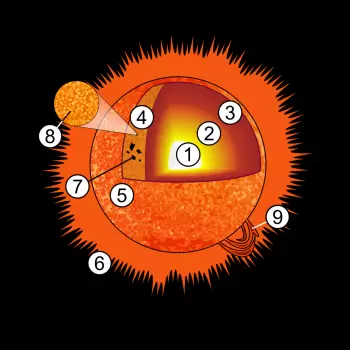Labeled Layers Of The Sun

The construction of the Lord's day is represented in unlike spherical layers hard to determine with a physical boundary.
The different layers of the Lord's day are determined by the concrete function they perform. Currently, astrophysics has a model of the solar structure made up of half-dozen layers divided into ii groups: the inner and outer layers of the Sunday.
The only layers of the Sun that can be observed directly are the outer layers: photosphere, chromosphere, and corona. These 3 layers make up the solar atmosphere.
Starting from an inner core and moving outward, the layers of the Sun are:
1. Solar Core
The core of the solar Sunday is the layer where nuclear fusion reactions are generated. Therefore, it is where all the energy is generated. It is equanimous of gas that appears as a plasma due to high temperature (almost 15 million degrees Celsius) and force per unit area due to its own magnetic field. High pressure is necessary for nuclear fusion to occur.
Nuclear reactions are the source of energy generating more energy than 80% of the other stars in the Milky Way.
Thermal energy has been transmitted through electromagnetic waves for 4,603 billion years. This phenomenon of electromagnetic waves is solar radiation.
ii. Radiant Zone of the Sun
In the surface area outside the solar core, the ship of the energy generated inside is produced past radiation to the radioactive surface area. This zone is composed of plasma, that is, large amounts of ionized hydrogen and helium.
In this area, the temperature decreases as we motility away from the nucleus. These temperature differences favor the photons moving outwards.
iii. Convective Zone of the Sunday.
Located above the radiant area. Solar gases are no longer ionized and photons are easily absorbed. Consequently, the photons are no longer transported past radiation.
The transport of energy is carried out by convection. Heat is transported in an inhomogeneous and turbulent mode by the fluid itself.
Turbulent convective sections are formed, in which patches of hot and light gas rising up to the photosphere. In the photosphere the solar temper becomes transparent to radiation and the hot gas gives up its free energy in the class of visible calorie-free.
4. Photosphere
The photosphere generates almost all of the visible light that the star emits into space. The photosphere is the start of the outer layers of the Sun.
In the photosphere, sunspots (7) are formed, which are nighttime spots on the solar surface due to their much lower temperature. Most solar flares (9) appear around sun spots.
The width of the photosphere is approximately 400 kilometers, and the temperature varies between vii,500 and 4,700 Kelvin, decreasing equally it moves away from the nucleus.
5. Chromosphere
The chromosphere is believed to be 2,000 to 3,000 kilometers broad. Every bit it moves away from the nucleus, the density of the chromosphere decreases and the temperature increases from 4,500 to 100,000 degrees Celsius.
6. Crown, the Outer Layer of the Dominicus.
Its width is a few million kilometers. The full luminosity is just half the luminosity of the total moon.
The density of matter at the base of the corona is 109 atoms per square centimeter.
The temperature of the corona generally oscillates around one meg kelvins.
Published: July 28, 2021
Terminal review: Baronial 8, 2021

Labeled Layers Of The Sun,
Source: https://solar-energy.technology/solar-system/sun/structure
Posted by: freyfraidgetefe.blogspot.com


0 Response to "Labeled Layers Of The Sun"
Post a Comment